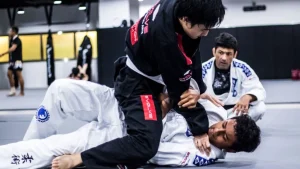In the fast-paced world of Jiu Jitsu training, staying ahead of the game is crucial for practitioners aiming to improve their skills and gain a competitive edge. This article explores the latest training trends in Jiu Jitsu, examining innovative techniques, state-of-the-art equipment, and ground-breaking methodologies that are shaping the future of this dynamic martial art.
Whether you’re a seasoned practitioner or a beginner starting your Jiu Jitsu journey, this comprehensive analysis offers valuable knowledge and insights to optimize your training routine and enhance your performance on the mat.
Key Takeaways
- Jiu Jitsu training has evolved to incorporate a holistic approach to physical and mental development, including strength and conditioning exercises and mindfulness training.
- The sport has seen the emergence of new techniques and strategies such as leg locks, berimbolo, and pressure passing, which are revolutionizing the sport.
- Technology has had a significant impact on Jiu Jitsu training, making it more convenient and accessible through online platforms, video-sharing websites, and specialized software and apps.
- Training trends cater to practitioners of all skill levels, including drilling techniques, live rolling, strength and conditioning exercises, and competition training sessions.
Current State of Jiu Jitsu Training
Analyzing the evolving landscape of Jiu Jitsu training is crucial for understanding the current state of this martial art.
Jiu Jitsu training trends has seen significant growth and development over the years, with practitioners continually seeking new techniques and training methods to improve their skills.
One of the key trends in Jiu Jitsu training is the emphasis on a holistic approach to physical and mental development. Many practitioners now incorporate strength and conditioning exercises, as well as mindfulness and mental resilience training, to complement their technical training.
Additionally, there has been a shift towards more specialized training programs, catering to different skill levels and goals. This allows practitioners to focus on specific aspects of Jiu Jitsu, such as self-defense, sport competition, or MMA application.
Emerging Techniques and Strategies
One of the notable developments in Jiu Jitsu training is the emergence of new techniques and strategies that are revolutionizing the sport. These innovative approaches are helping practitioners enhance their skills and stay ahead in competitions.
Here are four emerging techniques and strategies that are currently making waves in the Jiu Jitsu community:
- Leg locks: Traditionally, Jiu Jitsu focused on chokes and joint locks. However, leg locks have gained popularity in recent years, with practitioners like Eddie Cummings showcasing their effectiveness in competitions.
- Berimbolo: This technique, popularized by the Mendes brothers, involves inverting and rolling under an opponent to gain an advantageous position. It requires flexibility, timing, and precision.
- Pressure passing: Rather than relying solely on speed and agility, pressure passing emphasizes controlling and immobilizing the opponent through strong pressure and positioning.
- Submission-only tournaments: These tournaments have gained traction as they encourage a more aggressive and dynamic style of fighting, where competitors aim for submissions rather than relying on points.
Impact of Technology on Jiu Jitsu Training
The impact of technology on Jiu Jitsu training is undeniable, as it has revolutionized the way practitioners learn, analyze, and improve their skills. With the advent of various technological tools and resources, Jiu Jitsu practitioners now have access to a wealth of information and training methods that were once inaccessible.

Online platforms and video-sharing websites have allowed practitioners to learn from top-level instructors and study techniques from around the world. Additionally, the development of specialized software and apps has enabled practitioners to track their progress, analyze their performance, and identify areas for improvement.
These technological advancements have not only made Jiu Jitsu training more convenient and accessible, but they have also provided practitioners with a sense of belonging to a larger Jiu Jitsu community, where they can connect with fellow practitioners, share knowledge, and support each other’s journeys.
Training Trends for Different Skill Levels
There are several key training trends that cater to different skill levels in Jiu Jitsu. These trends are designed to help practitioners of all levels improve their techniques, increase their strength and conditioning, and enhance their overall performance on the mat.
Here are four training trends that are currently popular among Jiu Jitsu practitioners of different skill levels:
- Drilling: This trend involves repetitive practice of specific techniques and movements to improve muscle memory and technique execution.
- Live rolling: This trend emphasizes sparring and rolling with training partners to apply techniques in a live, dynamic setting.
- Strength and conditioning: This trend focuses on improving physical fitness through exercises and workouts specific to Jiu Jitsu, such as kettlebell training and bodyweight exercises.
- Competition training: This trend involves specific training sessions dedicated to preparing for Jiu Jitsu tournaments, including mock matches and situational training.
Adapting to Evolving Jiu Jitsu Competition Rules
As Jiu Jitsu practitioners strive to stay ahead in the ever-evolving landscape of competition, it becomes crucial to adapt to the changing Jiu Jitsu competition rules. In recent years, there have been several notable updates and modifications to the rules, which have had a significant impact on the way matches are fought and won.
One of the most prominent changes is the increased emphasis on submission attempts. Previously, competitors could win a match by accumulating points through takedowns and dominant positions. However, the current trend is to prioritize submission attempts, rewarding aggressive and dynamic grappling.
Furthermore, the introduction of time limits and overtime rounds has also altered the strategies and approaches in Jiu Jitsu competitions. Competitors now have to be more mindful of time management and pacing, as matches can be decided in sudden-death overtime periods.
To adapt to these evolving rules, practitioners must stay updated with the latest rule changes and adjust their training accordingly. This may involve focusing more on submission techniques, refining time management skills, and developing strategies for overtime scenarios.
Frequently Asked Questions
How Has the Current State of Jiu Jitsu Training Evolved Over the Years?
The current state of jiu jitsu training has evolved significantly over the years. With advancements in technology and the increasing popularity of the sport, practitioners now have access to a wide range of training methods and resources.
Training has become more specialized, with athletes focusing on specific techniques and strategies to improve their performance. Moreover, there has been a shift towards a more holistic approach to training, incorporating strength and conditioning exercises, mental preparation, and injury prevention techniques.
What Are Some Emerging Techniques and Strategies in Jiu Jitsu Training?
Some emerging techniques and strategies in jiu jitsu training include:
- The use of leg locks, such as heel hooks and knee bars, which have gained popularity due to their effectiveness in submissions.
- The berimbolo sweep, made famous by the Mendes brothers, is a complex and dynamic move that allows practitioners to gain an advantageous position.
- Additionally, many jiu jitsu practitioners are now integrating wrestling techniques into their training to improve takedowns and control on the ground.
How Has Technology Impacted Jiu Jitsu Training?
Technology has had a significant impact on jiu-jitsu training, revolutionizing the way practitioners learn and improve their skills.
With the advent of online platforms and instructional videos, students now have access to a vast library of techniques and strategies from top-level instructors worldwide.
Additionally, training aids such as wearable devices and video analysis software have allowed practitioners to track their progress, identify areas for improvement, and enhance their training efficiency.
What Are Some Training Trends for Different Skill Levels in Jiu Jitsu?
Training trends in jiu jitsu vary depending on the skill level of the practitioner. Beginners often focus on fundamental techniques and building a solid foundation.
Intermediate practitioners may explore more advanced techniques and strategies to enhance their game.
Advanced practitioners may engage in specialized training, such as competition preparation or advanced submission techniques.
Cross-training with other martial arts or incorporating strength and conditioning exercises are also popular trends.
These trends reflect the evolving nature of jiu jitsu training and the diverse needs of practitioners at different skill levels.
How Can Athletes Adapt to Evolving Jiu Jitsu Competition Rules?
Athletes can adapt to evolving jiu jitsu competition rules by staying updated on the latest rule changes and regulations. This can be done by regularly reading and studying the rulebooks provided by the governing bodies of the sport.
Additionally, athletes can participate in training sessions and workshops specifically focused on understanding and implementing the new rules.
It is also important for athletes to practice and drill techniques that align with the current rule set, ensuring they are prepared to compete within the boundaries of the sport.
Conclusion
In conclusion, staying up-to-date with the latest training trends in Jiu Jitsu is essential for practitioners to enhance their skills and stay competitive.
This article has explored various aspects of Jiu Jitsu training, including innovative techniques, cutting-edge equipment, and revolutionary training methodologies.
By understanding and incorporating these trends into their routines, Jiu Jitsu enthusiasts can optimize their training and improve their overall performance.
Whether a seasoned practitioner or a beginner, knowledge of the top training trends will provide valuable insights for success in this dynamic martial art.
You May Also Like:

